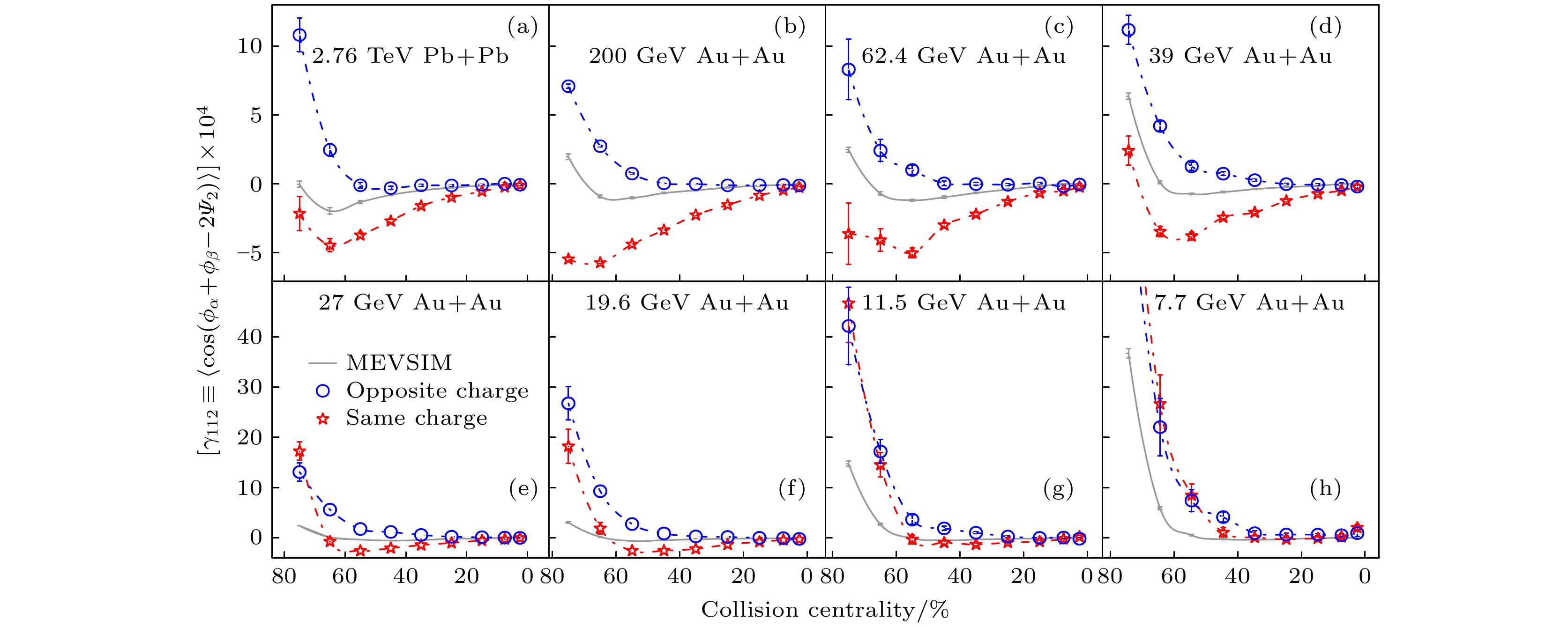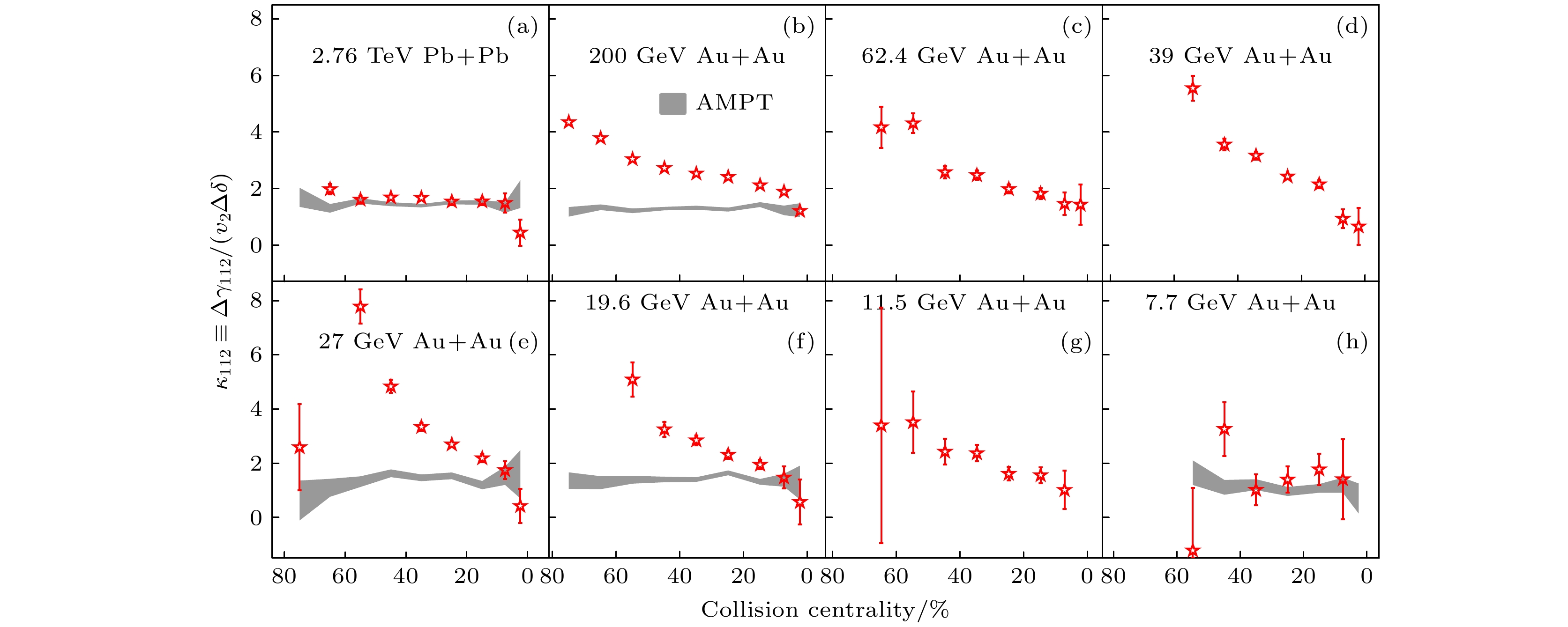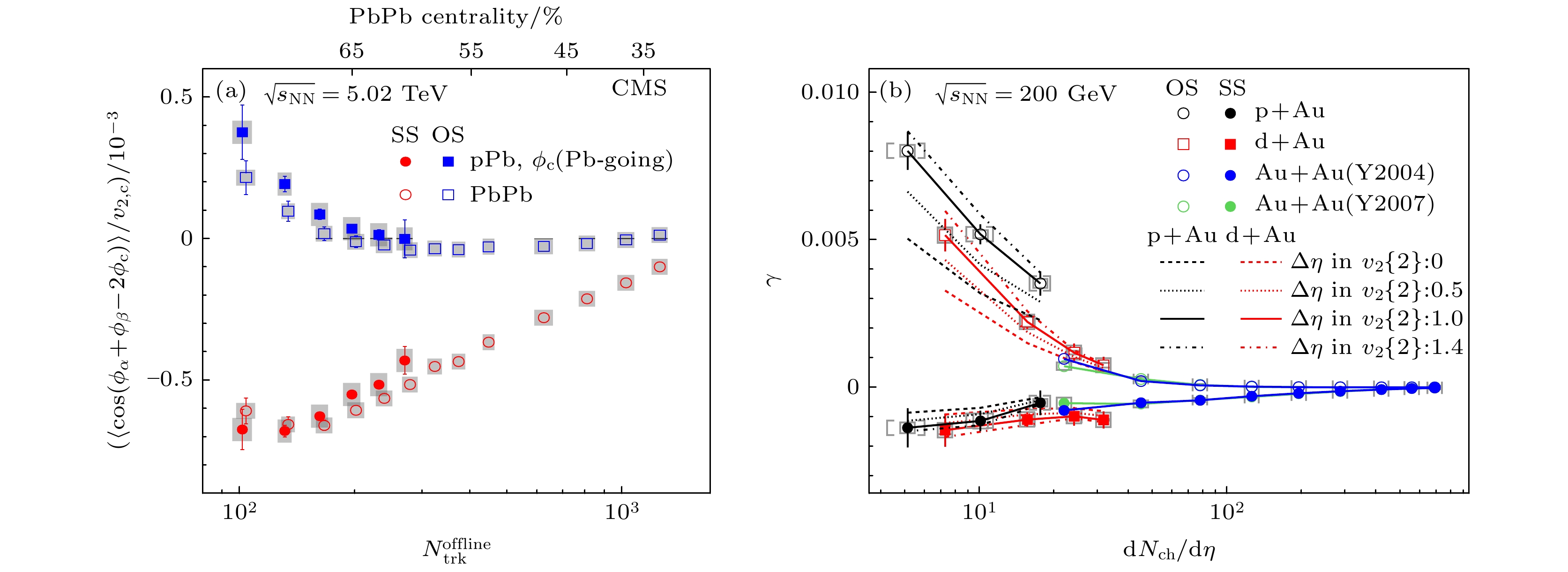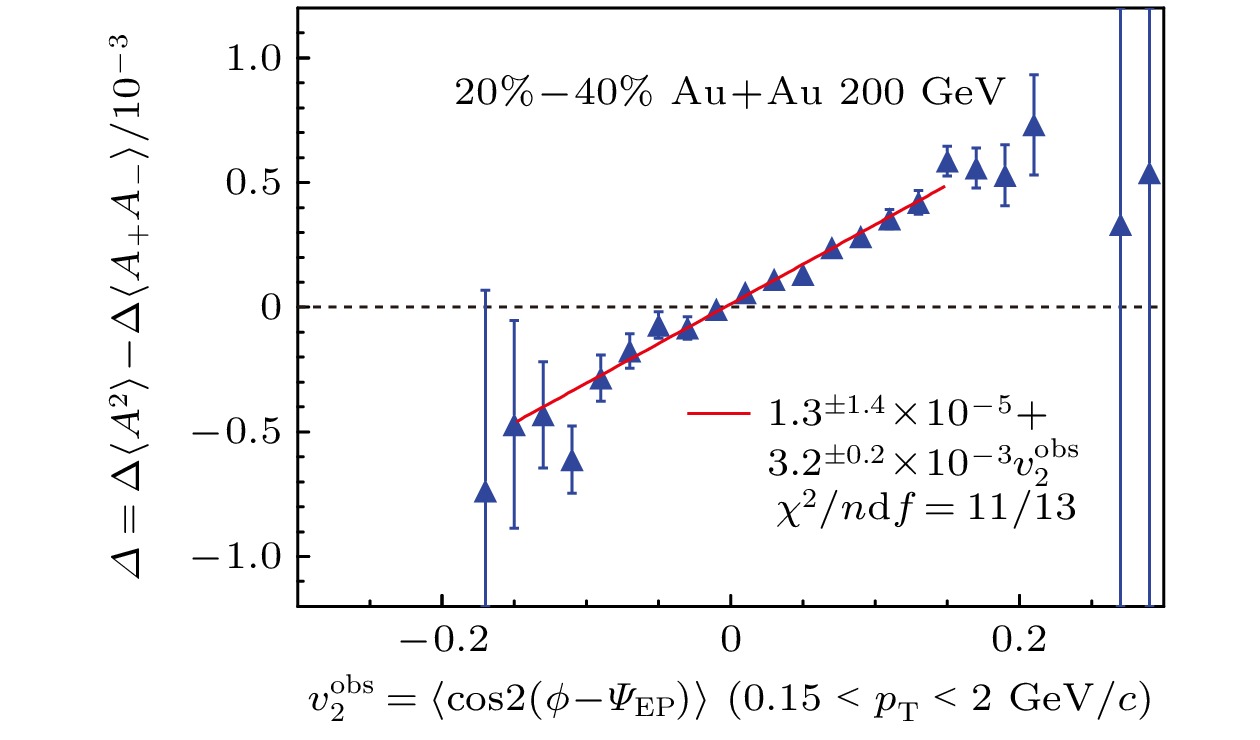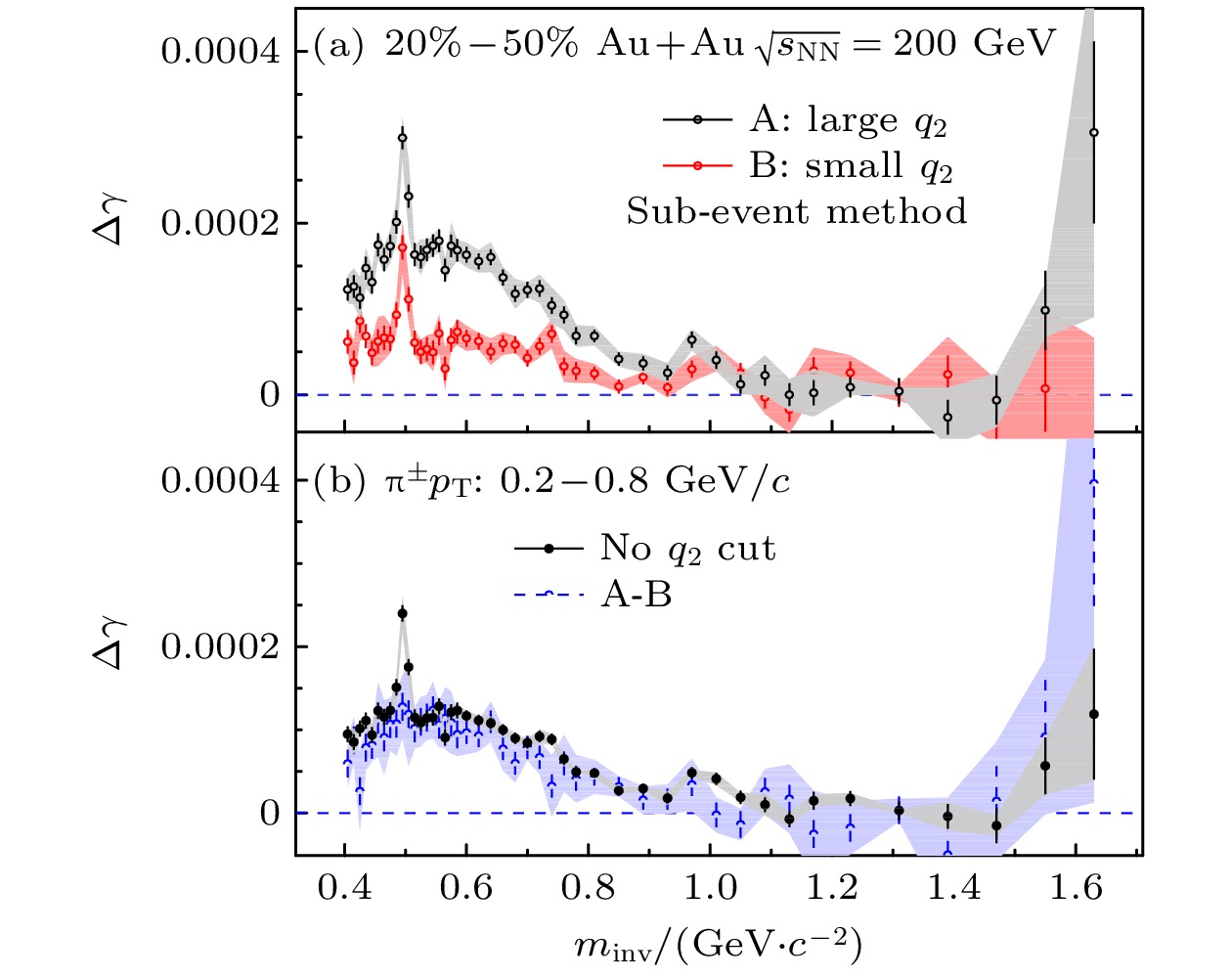-
In quantum chromodynamics, the interactions of quarks with the topological gluon field can lead to nonconservation of local parity (P) and conjugated parity (CP) , which provides a solution to the strong CP problem and a possibility to explain the asymmetry of matter-antimatter in the current universe. Under the action of a strong magnetic field, the nonconservation of P and CP can lead to the separation of particles according to their electric charges, which is called the chiral magnetic effect (CME). An observation of the CME-induced charge separation will confirm several fundamental properties of quantum chromodynamics (QCD), namely, approximate chiral symmetry restoration, topological charge fluctuation, and local parity violation. In relativistic heavy-ion collisions, there are other chiral anomalous effects similar to the CME, such as the chiral vortical effect (CVE) and the chiral magnetic wave (CMW). This review briefly summarizes the current progress of experimental research on the CME, CVE, and CMW in relativistic heavy-ion collisions.
[1] Belavin A A, Polyakov A M, Schwartz A S, Tyupkin Y S 1975 Phys. Lett. B 59 85
 Google Scholar
Google Scholar
[2] Callan C G, Dashen R F, Gross D J 1976 Phys. Lett. B 63 334
 Google Scholar
Google Scholar
[3] Hooft G T 1976 Phys. Rev. D 14 3432
[4] Schäfer T, Shuryak E V 1998 Rev. Mod. Phys. 70 323
 Google Scholar
Google Scholar
[5] Kharzeev D E, Levin E M. 2015 Phys. Rev. Lett. 114 242001
 Google Scholar
Google Scholar
[6] Adler S L 1969 Phys. Rev. 177 2426
 Google Scholar
Google Scholar
[7] Bell J S, Jackiw R 1969 Nuovo Cim. A 60 74
[8] Kharzeev D E 2006 Phys. Lett. B 633 260
 Google Scholar
Google Scholar
[9] Kharzeev D E, McLerran L D, Warringa H J 2008 Nucl. Phys. A2008 227
[10] Li Q, Kharzeev D E, Zhang C, Huang Y, Pletikosic I, Fedorov A V, Zhong R D, Schneeloch J A, Gu G D, Valla T 2016 Nat. Phys. 12 550
 Google Scholar
Google Scholar
[11] Xiong J, Kushwaha S K, Liang T, Krizan J W, Hirschberger M, Wang W, Cava R J, Ong N P 2015 Science 350 413
 Google Scholar
Google Scholar
[12] Li C Z, Wang L X, Liu H W, Wang J, Liao Z M, Yu D P 2015 Nat. Commun. 6 10137
 Google Scholar
Google Scholar
[13] Long Y J, Wang P P, Chen D, Yang Z H, Liang H, Xue M Q, Weng H M, Fang Z, Dai X, Chen G F, Huang X C, Zhao L X 2015 Phys. Rev. X 5 031023
[14] Kharzeev D E, Liao J F, Voloshin S A, Wang G 2016 Prog. Part. Nucl. Phys. 88 1
 Google Scholar
Google Scholar
[15] Zhao J 2018 Int. J. Mod. Phys. A 33 1830010
 Google Scholar
Google Scholar
[16] Zhao J, Tu Z, Wang F Q 2018 Nucl. Phys. Rev. 35 225
[17] Zhao J, Wang F Q 2019 Prog. Part. Nucl. Phys. 107 200
 Google Scholar
Google Scholar
[18] Li W, Wang G 2020 Ann. Rev. Nucl. Part. Sci. 70 293
 Google Scholar
Google Scholar
[19] Kharzeev D E, Liao J F 2021 Nat. Rev. Phys. 3 55
[20] Abelev B I, Aggarwal M M, Ahammed Z, et al. 2009 Phys. Rev. Lett. 103 251601
 Google Scholar
Google Scholar
[21] Abelev B I, Aggarwal M M, Ahammed Z, et al. 2010 Phys. Rev. C 81 054908
 Google Scholar
Google Scholar
[22] Adamczyk L, Adkins J K, Agakishiev G, et al. 2014 Phys. Rev. Lett. 113 052302
 Google Scholar
Google Scholar
[23] Abelev B I, Adam J , Adamova D, et al. 2013 Phys. Rev. Lett. 110 012301
 Google Scholar
Google Scholar
[24] Voloshin S A 2004 Phys. Rev. C 70 057901
 Google Scholar
Google Scholar
[25] Pratt S, Schlichting S, Gavin S 2011 Phys. Rev. C 84 024909
 Google Scholar
Google Scholar
[26] Bzdak A, Koch V, Liao J F 2013 Lect. Notes Phys. 871 503
[27] Schlichting S, Pratt S 2011 Phys. Rev. C 83 014913
 Google Scholar
Google Scholar
[28] Lin Z W, Ko C M, Li B A, Zhang B, Pal S 2005 Phys. Rev. C 72 064901
 Google Scholar
Google Scholar
[29] Lin Z W 2014 Phys. Rev. C 90 014904
 Google Scholar
Google Scholar
[30] Lin Z W, Zheng L 2021 Nucl. Sci. Tech. 32 113
 Google Scholar
Google Scholar
[31] Zhang H X, Xiao Y X, Kang J W, Zhang B W 2022 Nucl. Sci. Tech. 33 150
 Google Scholar
Google Scholar
[32] Khachatryan V, et al. 2017 Phys. Rev. Lett. 118 122301
 Google Scholar
Google Scholar
[33] Adam J, et al. 2019 Phys. Lett. B 798 134975
 Google Scholar
Google Scholar
[34] Zhao J, Feng Y C, Li H L, Wang F Q 2020 Phys. Rev. C 101 034912
 Google Scholar
Google Scholar
[35] Adamczyk L, et al. 2014 Phys. Rev. C 89 044908
 Google Scholar
Google Scholar
[36] Tu B In Poster Given at 25th International Conference on Ultrarelativistic Nucleus-Nucleus Collisions (Quark Matter 2015) Kobe, Japan, September 27-October 3, 2015
[37] Acharya S, et al. 2018 Phys. Lett. B 777 151
 Google Scholar
Google Scholar
[38] Sirunyan A M, et al. 2018 Phys. Rev. C 97 044912
 Google Scholar
Google Scholar
[39] Wang F Q, Zhao J 2017 Phys. Rev. C 95 051901 (R
 Google Scholar
Google Scholar
[40] Zhao J, Li H L, Wang F Q 2019 Eur. Phys. J. C 79 168
 Google Scholar
Google Scholar
[41] Abdallah M S, et al. 2022 Phys. Rev. C 106 034908
 Google Scholar
Google Scholar
[42] Xu H J, Zhao J, Wang X B, Li H L, Lin Z W, Shen C W, Wang F Q 2018 Chin. Phys. C 42 084103
 Google Scholar
Google Scholar
[43] Abdallah M S, et al. 2022 Phys. Rev. Lett. 128 092301
 Google Scholar
Google Scholar
[44] Abdallah M, et al. 2022 Phys. Rev. C 105 014901
 Google Scholar
Google Scholar
[45] Voloshin S A 2010 Phys. Rev. Lett. 105 172301
 Google Scholar
Google Scholar
[46] Deng W T, Huang X G, Ma G L, Wang G 2016 Phys. Rev. C 94 041901
 Google Scholar
Google Scholar
[47] Koch V, Schlichting S, Skokov V, Sorensen P, Thomas J, Voloshin S, Wang G, Yee H U 2017 Chin. Phys. C 41 072001
 Google Scholar
Google Scholar
[48] Adam J, et al. 2021 Nucl. Sci. Tech. 32 48
 Google Scholar
Google Scholar
[49] Choudhury S, et al. 2022 Chin. Phys. C 46 014101
 Google Scholar
Google Scholar
[50] Xu H J, Wang X B, Li H L, Zhao J, Lin Z W, Shen C W, Wang F Q 2018 Phys. Rev. Lett. 121 022301
 Google Scholar
Google Scholar
[51] Li H L, Xu H J, Zhou Y, Wang X B, Zhao J, Chen L W, Wang F Q 2020 Phys. Rev. Lett. 125 222301
 Google Scholar
Google Scholar
[52] Feng Y C 2023 EPJ Web Conf. 276 06013
[53] Kharzeev D E, Liao J F, Shi S Z 2022 Phys. Rev. C 106 L051903
 Google Scholar
Google Scholar
[54] Feng Y C, Lin Y F, Zhao J, Wang F Q 2021 Phys. Lett. B 820 136549
 Google Scholar
Google Scholar
[55] Tang A H 2020 Chin. Phys. C 44 054101
 Google Scholar
Google Scholar
[56] Shi S Z, Jiang Y, Lilleskov E, Liao J F 2018 Annals Phys. 394 50
 Google Scholar
Google Scholar
[57] Jiang Y, Shi S Z, Yin Y, Liao J F 2018 Chin. Phys. C 42 011001
 Google Scholar
Google Scholar
[58] Shi S Z, Zhang H, Hou D F, Liao J F 2020 Phys. Rev. Lett. 125 242301
 Google Scholar
Google Scholar
[59] Ajitanand N N, Lacey R A, Taranenko A, Alexander J M 2011 Phys. Rev. C 83 011901
 Google Scholar
Google Scholar
[60] Magdy N, Shi S Z, Liao J F, Ajitanand N N, Lacey R A 2018 Phys. Rev. C 97 061901
 Google Scholar
Google Scholar
[61] Liu Y C, Huang X G 2020 Nucl. Sci. Tech. 31 56
 Google Scholar
Google Scholar
[62] Gao J H, Ma G L, Pu S, Wang Q 2020 Nucl. Sci. Tech. 31 90
 Google Scholar
Google Scholar
[63] 赵新丽, 马国亮, 马余刚 2023 物理学报 72 112502
 Google Scholar
Google Scholar
Zhao X L, Ma G L, Ma Y G 2023 Acta Phys. Sin. 72 112502
 Google Scholar
Google Scholar
[64] Kharzeev D E, Son D T 2011 Phys. Rev. Lett. 106 062301
 Google Scholar
Google Scholar
[65] Jiang Y, Lin Z W, Liao J F 2016 Phys. Rev. C 94 044910
 Google Scholar
Google Scholar
[66] Baznat M, Gudima M, Sorin A, Teryaev O 2016 Phys. Rev. C 93 031902
 Google Scholar
Google Scholar
[67] Zhao F 2014 Nucl. Phys. A 931 746
 Google Scholar
Google Scholar
[68] Zhao J 2017 EPJ Web Conf. 141 01010
 Google Scholar
Google Scholar
[69] Wen L W 2017 Nucl. Phys. A 967 756
 Google Scholar
Google Scholar
[70] Son D T, Zhitnitsky A R 2004 Phys. Rev. D 70 074018
 Google Scholar
Google Scholar
[71] Metlitski M A, Zhitnitsky A R 2005 Phys. Rev. D 72 045011
 Google Scholar
Google Scholar
[72] Burnier Y, Kharzeev D E, Liao J F, Yee H U 2011 Phys. Rev. Lett. 107 052303
 Google Scholar
Google Scholar
[73] Adamczyk L, Adkins J K, Agakishiev G, et al. 2015 Phys. Rev. Lett. 114 252302
 Google Scholar
Google Scholar
[74] Adam J, et al. 2016 Phys. Rev. C 93 044903
 Google Scholar
Google Scholar
[75] Bzdak A, Boek P 2013 Phys. Lett. B 726 239
[76] STAR Collaboration Search for the Chiral Magnetic Wave Using Anisotropic Flow of Identified Particles at RHIC arXiv: 2210.14027
[77] Sirunyan A M, et al. 2019 Phys. Rev. C 100 064908
 Google Scholar
Google Scholar
[78] Xu H J, Zhao J, Feng Y C, Wang F Q 2021 Nucl. Phys. A 1005 121770
 Google Scholar
Google Scholar
[79] Ma G L 2014 Phys. Lett. B 735 383
 Google Scholar
Google Scholar
[80] Voloshin S A, Belmont R 2014 Nucl. Phys. A 931 992
 Google Scholar
Google Scholar
[81] Xu H J, Zhao J, Feng Y C, Wang F Q 2020 Phys. Rev. C 101 014913
 Google Scholar
Google Scholar
[82] Wu W Y, Wang C Z, Shou Q Y, Ma Y G, Zheng L 2021 Phys. Rev. C 103 034906
 Google Scholar
Google Scholar
[83] Wang C Z, Wu W Y, Shou Q Y, Ma G L, Ma Y G, Zhang S 2021 Phys. Lett. B 820 136580
 Google Scholar
Google Scholar
[84] Wu W Y 2023 EPJ Web Conf. 276 01001
[85] Hatta Y, Monnai A, Xiao B W 2016 Nucl. Phys. A 947 155
 Google Scholar
Google Scholar
-
图 1 RHIC-STAR合作组于2009年左右对
$ \gamma_{112} $ 关联函数的首次测量结果[20,21]. 粗实线和虚线表示HIJING模型计算的三粒子关联背景贡献. 碰撞中心度从左到右增加; 0%对应于中心碰撞Figure 1. First measurement of the
$ \gamma_{112} $ correlator from RHIC-STAR experiment around 2009[20,21]. The thick solid (Au+Au) and dashed (Cu+Cu) lines represent HIJING calculations of the contributions from three-particle correlations. Collision centrality increases from left to right. 0% corresponds to the most central collisions图 2 RHIC-STAR 7.7—200 GeV Au+Au以及LHC-ALICE 2.76 TeV Pb+Pb碰撞中
$ \gamma_{112} $ 关联函数的中心度依赖性[20-23]. 灰色线是MEVSIM模型估计的与电荷无关的背景贡献Figure 2.
$ \gamma_{112} $ correlator as a function of centrality for Au+Au collisions at 7.7–200 GeV from RHIC-STAR, and for Pb+Pb collisions at 2.76 TeV from LHC-ALICE[20-23]. Gray curves are the charge-independent results from MEVSIM calculations图 3 RHIC-STAR 7.7—200 GeV Au+Au以及LHC-ALICE 2.76 TeV Pb+Pb碰撞中
$ \kappa_{112} $ 关联函数的中心度依赖性[20-23]. 灰色粗实线是AMPT模型估计的与CME无关的背景贡献[28-30]Figure 3.
$ \kappa_{112} $ correlator as a function of centrality for Au+Au collisions at 7.7–200 GeV from RHIC-STAR, and for Pb+Pb collisions at 2.76 TeV from LHC-ALICE[20-23]. Gray curves are the non-CME background estimations from AMPT[28-30]图 4 (a) LHC-CMS合作组在5.02 TeV p+Pb和 Pb+Pb碰撞中测量的
$ \gamma_{112} $ 关联函数随多重数的依赖性[32]; (b) RHIC-STAR合作组测量的小系统p+Au, d+Au碰撞中$ \gamma_{112} $ 关联函数与Au+Au碰撞结果的对比[33]. 图中的灰色标记代表实验测量的系统误差Figure 4. (a)
$ \gamma_{112} $ as a function of N in p+Pb and Pb+Pb collisions at 5.02 TeV from LHC-CMS collaboration[32]; (b)$ \gamma_{112} $ as a function of N in p+Au, d+Au and Au+Au collisions at 200 GeV from RHIC-STAR collaboration[33]. Systematic uncertainties are indicated by the shaded regions图 6 LHC-ALICE合作组(a)通过事件形状筛选方法在2.76 TeV Pb+Pb碰撞中测量的按粒子多重数缩放的
$ \Delta\gamma_{112} $ 关联函数($\Delta\gamma_{112} \cdot {\rm{d}}N_{\rm ch}/{\rm{d}}\eta$ )在不同中心度下随$ v_{2} $ 的关系, (b)通过事件形状筛选方法比较关联函数以及不同模型下磁场强度和$ v_{2} $ 的关系, 提取的手征磁效应的贡献[37]Figure 6. (a) Charge-particle density scaled correlator (
$\Delta\gamma_{112} \cdot {\rm{d}}N_{\rm ch}/{\rm{d}}\eta$ ) as a function of$ v_{2} $ for shape selected events in 2.76 TeV Pb+Pb collisions from LHC-ALICE; (b) extracted CME fraction ($ f_{\rm CME} $ ) by comparing the correlator and magnetic field dependence on$ v_{2} $ with different models[37]图 7 LHC-CMS合作组(a)通过事件形状筛选方法在5.02 TeV Pb+Pb碰撞中测量的按
$ \Delta\delta $ 缩放的关联函数($ \Delta\gamma_{112}/\Delta\delta $ )在不同中心度下随$ v_{2} $ 的关系, (b)通过事件形状筛选方法研究关联函数在$ v_{2}=0 $ 的结果, 提取的Pb+Pb以及p+Pb碰撞中手征磁效应的贡献[38]Figure 7. (a) Scaled correlator,
$ \Delta\gamma_{112}/\Delta\delta $ , as a function of$ v_{2} $ evaluated with the ESE method, for different multiplicity ranges in Pb+Pb collisions from LHC-CMS; (b) extracted CME contributions,$ v_{2} $ -independent component, in Pb+Pb and p+Pb collisions[38]图 8 RHIC-STAR合作组(a)通过事件形状筛选方法选择的不同
$ q_{2} $ 事件(A: large$ q_{2} $ , B: small$ q_{2} $ )中$ \Delta\gamma_{112} $ 关联函数与不变质量的关系, (b) A-B与无事件形状筛选的测量结果的比较[41]Figure 8. (a)
$ \Delta\gamma_{112} $ as functions of mass in different$ q_{2} $ events (A: large$ q_{2} $ , B: small$ q_{2} $ ) using the event shape selection method; (b) inclusive measurement compared with the A-B[41]图 12 基于EBE-AVFD模拟数据计算的
$ \Delta \gamma_{112} $ (a),$ \sigma^{-1}_{R2} $ ($ \sigma_{R2} $ 为R关联函数宽度) (c) 和$ r_{\mathrm{lab}} $ (e) 关于$ n_{5}/s $ 的函数.$ n_{5}/s $ 在AVFD里表示原始植入的CME强度. 该计算是针对30%—40% 中心度同位异素$ \sqrt{s_{\rm NN}} = 200 $ GeV核核对撞. (b), (d), (f)观测量在Ru+Ru对Zr+Zr比值[49]Figure 12.
$ \Delta \gamma_{112} $ (a),$ \sigma^{-1}_{R2} $ (c) and$ r_{\mathrm{lab}} $ (e) as functions of$ n_{5}/s $ in EBE-AVFD model simulation. (b), (d), (f) Corresponding ratios between Ru+Ru and Zr+Zr[49]图 13 (a) STAR实验200 GeV Au+Au对撞中
$ v_2^\pm $ -$ A_{\rm ch} $ 的关系和(b)$ \Delta v_2 $ -$ A_{\rm ch} $ 的关系[73]; (c) ALICE实验2.76 TeV Pb+ Pb对撞中$ \Delta v_2 $ -$ A_{\rm ch} $ 的关系 [74]Figure 13. (a)
$ v_2^\pm $ , (b)$ \Delta v_2 $ as functions of$ A_{\rm ch} $ in 200 GeV Au+Au collisions from STAR [73]; (c)$ \Delta v_2 $ as functions of$ A_{\rm ch} $ in 2.76 TeV Pb+Pb collisions from ALICE[74]图 15 (a) STAR实验200 GeVAu+Au对撞和(b) CMS实验5.02 TeV Pb+Pb对撞中观测到的
$ r_2 $ 、$ r_3 $ 斜率, 在误差范围内基本一致[76,77]Figure 15. Measured
$ r_2 $ ,$ r_3 $ slopes as functions of centrality in 200 GeV Au+Au collisions from STAR (a), and in 5.02 TeV Pb+Pb collisions from CMS (b), within the uncertainties, the slopes of$ r_2 $ ,$ r_3 $ are consistent with each other[76,77]图 16 (a) STAR实验200 GeVAu+Au、U+U、p+Au和d+Au对撞和(b) CMS实验5.02 TeV Pb+Pb和p+Pb对撞中观测到的
$ r_2 $ 斜率[76,77]Figure 16. Measured
$ r_2 $ slopes as functions of multiplicity (a) in small system collisions of 200 GeV p+A, d+Au compared with Au+Au and U+U from STAR, and (b) in 5.02 TeV p+Pb and Pb+Pb collisions from CMS[76,77] -
[1] Belavin A A, Polyakov A M, Schwartz A S, Tyupkin Y S 1975 Phys. Lett. B 59 85
 Google Scholar
Google Scholar
[2] Callan C G, Dashen R F, Gross D J 1976 Phys. Lett. B 63 334
 Google Scholar
Google Scholar
[3] Hooft G T 1976 Phys. Rev. D 14 3432
[4] Schäfer T, Shuryak E V 1998 Rev. Mod. Phys. 70 323
 Google Scholar
Google Scholar
[5] Kharzeev D E, Levin E M. 2015 Phys. Rev. Lett. 114 242001
 Google Scholar
Google Scholar
[6] Adler S L 1969 Phys. Rev. 177 2426
 Google Scholar
Google Scholar
[7] Bell J S, Jackiw R 1969 Nuovo Cim. A 60 74
[8] Kharzeev D E 2006 Phys. Lett. B 633 260
 Google Scholar
Google Scholar
[9] Kharzeev D E, McLerran L D, Warringa H J 2008 Nucl. Phys. A2008 227
[10] Li Q, Kharzeev D E, Zhang C, Huang Y, Pletikosic I, Fedorov A V, Zhong R D, Schneeloch J A, Gu G D, Valla T 2016 Nat. Phys. 12 550
 Google Scholar
Google Scholar
[11] Xiong J, Kushwaha S K, Liang T, Krizan J W, Hirschberger M, Wang W, Cava R J, Ong N P 2015 Science 350 413
 Google Scholar
Google Scholar
[12] Li C Z, Wang L X, Liu H W, Wang J, Liao Z M, Yu D P 2015 Nat. Commun. 6 10137
 Google Scholar
Google Scholar
[13] Long Y J, Wang P P, Chen D, Yang Z H, Liang H, Xue M Q, Weng H M, Fang Z, Dai X, Chen G F, Huang X C, Zhao L X 2015 Phys. Rev. X 5 031023
[14] Kharzeev D E, Liao J F, Voloshin S A, Wang G 2016 Prog. Part. Nucl. Phys. 88 1
 Google Scholar
Google Scholar
[15] Zhao J 2018 Int. J. Mod. Phys. A 33 1830010
 Google Scholar
Google Scholar
[16] Zhao J, Tu Z, Wang F Q 2018 Nucl. Phys. Rev. 35 225
[17] Zhao J, Wang F Q 2019 Prog. Part. Nucl. Phys. 107 200
 Google Scholar
Google Scholar
[18] Li W, Wang G 2020 Ann. Rev. Nucl. Part. Sci. 70 293
 Google Scholar
Google Scholar
[19] Kharzeev D E, Liao J F 2021 Nat. Rev. Phys. 3 55
[20] Abelev B I, Aggarwal M M, Ahammed Z, et al. 2009 Phys. Rev. Lett. 103 251601
 Google Scholar
Google Scholar
[21] Abelev B I, Aggarwal M M, Ahammed Z, et al. 2010 Phys. Rev. C 81 054908
 Google Scholar
Google Scholar
[22] Adamczyk L, Adkins J K, Agakishiev G, et al. 2014 Phys. Rev. Lett. 113 052302
 Google Scholar
Google Scholar
[23] Abelev B I, Adam J , Adamova D, et al. 2013 Phys. Rev. Lett. 110 012301
 Google Scholar
Google Scholar
[24] Voloshin S A 2004 Phys. Rev. C 70 057901
 Google Scholar
Google Scholar
[25] Pratt S, Schlichting S, Gavin S 2011 Phys. Rev. C 84 024909
 Google Scholar
Google Scholar
[26] Bzdak A, Koch V, Liao J F 2013 Lect. Notes Phys. 871 503
[27] Schlichting S, Pratt S 2011 Phys. Rev. C 83 014913
 Google Scholar
Google Scholar
[28] Lin Z W, Ko C M, Li B A, Zhang B, Pal S 2005 Phys. Rev. C 72 064901
 Google Scholar
Google Scholar
[29] Lin Z W 2014 Phys. Rev. C 90 014904
 Google Scholar
Google Scholar
[30] Lin Z W, Zheng L 2021 Nucl. Sci. Tech. 32 113
 Google Scholar
Google Scholar
[31] Zhang H X, Xiao Y X, Kang J W, Zhang B W 2022 Nucl. Sci. Tech. 33 150
 Google Scholar
Google Scholar
[32] Khachatryan V, et al. 2017 Phys. Rev. Lett. 118 122301
 Google Scholar
Google Scholar
[33] Adam J, et al. 2019 Phys. Lett. B 798 134975
 Google Scholar
Google Scholar
[34] Zhao J, Feng Y C, Li H L, Wang F Q 2020 Phys. Rev. C 101 034912
 Google Scholar
Google Scholar
[35] Adamczyk L, et al. 2014 Phys. Rev. C 89 044908
 Google Scholar
Google Scholar
[36] Tu B In Poster Given at 25th International Conference on Ultrarelativistic Nucleus-Nucleus Collisions (Quark Matter 2015) Kobe, Japan, September 27-October 3, 2015
[37] Acharya S, et al. 2018 Phys. Lett. B 777 151
 Google Scholar
Google Scholar
[38] Sirunyan A M, et al. 2018 Phys. Rev. C 97 044912
 Google Scholar
Google Scholar
[39] Wang F Q, Zhao J 2017 Phys. Rev. C 95 051901 (R
 Google Scholar
Google Scholar
[40] Zhao J, Li H L, Wang F Q 2019 Eur. Phys. J. C 79 168
 Google Scholar
Google Scholar
[41] Abdallah M S, et al. 2022 Phys. Rev. C 106 034908
 Google Scholar
Google Scholar
[42] Xu H J, Zhao J, Wang X B, Li H L, Lin Z W, Shen C W, Wang F Q 2018 Chin. Phys. C 42 084103
 Google Scholar
Google Scholar
[43] Abdallah M S, et al. 2022 Phys. Rev. Lett. 128 092301
 Google Scholar
Google Scholar
[44] Abdallah M, et al. 2022 Phys. Rev. C 105 014901
 Google Scholar
Google Scholar
[45] Voloshin S A 2010 Phys. Rev. Lett. 105 172301
 Google Scholar
Google Scholar
[46] Deng W T, Huang X G, Ma G L, Wang G 2016 Phys. Rev. C 94 041901
 Google Scholar
Google Scholar
[47] Koch V, Schlichting S, Skokov V, Sorensen P, Thomas J, Voloshin S, Wang G, Yee H U 2017 Chin. Phys. C 41 072001
 Google Scholar
Google Scholar
[48] Adam J, et al. 2021 Nucl. Sci. Tech. 32 48
 Google Scholar
Google Scholar
[49] Choudhury S, et al. 2022 Chin. Phys. C 46 014101
 Google Scholar
Google Scholar
[50] Xu H J, Wang X B, Li H L, Zhao J, Lin Z W, Shen C W, Wang F Q 2018 Phys. Rev. Lett. 121 022301
 Google Scholar
Google Scholar
[51] Li H L, Xu H J, Zhou Y, Wang X B, Zhao J, Chen L W, Wang F Q 2020 Phys. Rev. Lett. 125 222301
 Google Scholar
Google Scholar
[52] Feng Y C 2023 EPJ Web Conf. 276 06013
[53] Kharzeev D E, Liao J F, Shi S Z 2022 Phys. Rev. C 106 L051903
 Google Scholar
Google Scholar
[54] Feng Y C, Lin Y F, Zhao J, Wang F Q 2021 Phys. Lett. B 820 136549
 Google Scholar
Google Scholar
[55] Tang A H 2020 Chin. Phys. C 44 054101
 Google Scholar
Google Scholar
[56] Shi S Z, Jiang Y, Lilleskov E, Liao J F 2018 Annals Phys. 394 50
 Google Scholar
Google Scholar
[57] Jiang Y, Shi S Z, Yin Y, Liao J F 2018 Chin. Phys. C 42 011001
 Google Scholar
Google Scholar
[58] Shi S Z, Zhang H, Hou D F, Liao J F 2020 Phys. Rev. Lett. 125 242301
 Google Scholar
Google Scholar
[59] Ajitanand N N, Lacey R A, Taranenko A, Alexander J M 2011 Phys. Rev. C 83 011901
 Google Scholar
Google Scholar
[60] Magdy N, Shi S Z, Liao J F, Ajitanand N N, Lacey R A 2018 Phys. Rev. C 97 061901
 Google Scholar
Google Scholar
[61] Liu Y C, Huang X G 2020 Nucl. Sci. Tech. 31 56
 Google Scholar
Google Scholar
[62] Gao J H, Ma G L, Pu S, Wang Q 2020 Nucl. Sci. Tech. 31 90
 Google Scholar
Google Scholar
[63] 赵新丽, 马国亮, 马余刚 2023 物理学报 72 112502
 Google Scholar
Google Scholar
Zhao X L, Ma G L, Ma Y G 2023 Acta Phys. Sin. 72 112502
 Google Scholar
Google Scholar
[64] Kharzeev D E, Son D T 2011 Phys. Rev. Lett. 106 062301
 Google Scholar
Google Scholar
[65] Jiang Y, Lin Z W, Liao J F 2016 Phys. Rev. C 94 044910
 Google Scholar
Google Scholar
[66] Baznat M, Gudima M, Sorin A, Teryaev O 2016 Phys. Rev. C 93 031902
 Google Scholar
Google Scholar
[67] Zhao F 2014 Nucl. Phys. A 931 746
 Google Scholar
Google Scholar
[68] Zhao J 2017 EPJ Web Conf. 141 01010
 Google Scholar
Google Scholar
[69] Wen L W 2017 Nucl. Phys. A 967 756
 Google Scholar
Google Scholar
[70] Son D T, Zhitnitsky A R 2004 Phys. Rev. D 70 074018
 Google Scholar
Google Scholar
[71] Metlitski M A, Zhitnitsky A R 2005 Phys. Rev. D 72 045011
 Google Scholar
Google Scholar
[72] Burnier Y, Kharzeev D E, Liao J F, Yee H U 2011 Phys. Rev. Lett. 107 052303
 Google Scholar
Google Scholar
[73] Adamczyk L, Adkins J K, Agakishiev G, et al. 2015 Phys. Rev. Lett. 114 252302
 Google Scholar
Google Scholar
[74] Adam J, et al. 2016 Phys. Rev. C 93 044903
 Google Scholar
Google Scholar
[75] Bzdak A, Boek P 2013 Phys. Lett. B 726 239
[76] STAR Collaboration Search for the Chiral Magnetic Wave Using Anisotropic Flow of Identified Particles at RHIC arXiv: 2210.14027
[77] Sirunyan A M, et al. 2019 Phys. Rev. C 100 064908
 Google Scholar
Google Scholar
[78] Xu H J, Zhao J, Feng Y C, Wang F Q 2021 Nucl. Phys. A 1005 121770
 Google Scholar
Google Scholar
[79] Ma G L 2014 Phys. Lett. B 735 383
 Google Scholar
Google Scholar
[80] Voloshin S A, Belmont R 2014 Nucl. Phys. A 931 992
 Google Scholar
Google Scholar
[81] Xu H J, Zhao J, Feng Y C, Wang F Q 2020 Phys. Rev. C 101 014913
 Google Scholar
Google Scholar
[82] Wu W Y, Wang C Z, Shou Q Y, Ma Y G, Zheng L 2021 Phys. Rev. C 103 034906
 Google Scholar
Google Scholar
[83] Wang C Z, Wu W Y, Shou Q Y, Ma G L, Ma Y G, Zhang S 2021 Phys. Lett. B 820 136580
 Google Scholar
Google Scholar
[84] Wu W Y 2023 EPJ Web Conf. 276 01001
[85] Hatta Y, Monnai A, Xiao B W 2016 Nucl. Phys. A 947 155
 Google Scholar
Google Scholar
Catalog
Metrics
- Abstract views: 9719
- PDF Downloads: 149
- Cited By: 0

















 DownLoad:
DownLoad:
